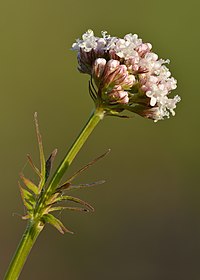
Photo from wikipedia
BACKGROUND Anxiety disorder is a common psychiatric illness. Medicinal herbs have become a field of interest in the treatment of anxiety. This study aimed to evaluate and compare the efficacy… Click to show full abstract
BACKGROUND Anxiety disorder is a common psychiatric illness. Medicinal herbs have become a field of interest in the treatment of anxiety. This study aimed to evaluate and compare the efficacy and acceptability of all possible medicinal herbs for the treatment of anxiety. METHODS A Bayesian network meta-analysis was conducted for adults with diagnosed or subthreshold anxiety in randomized controlled trials identified in PubMed, EMBASE, the Cochrane Library, and Web of Science, searched between Jan 1, 1987, and Dec 31, 2021. The outcomes included efficacy (measured by endpoint Hamilton Anxiety Scale [HAMA] Scores) and acceptability (discontinuation by ineffectiveness, worsening of the symptoms, or adverse events). RESULTS A total of 29 trials were reviewed, comparing 12 medicinal herbs. Silexan (mean difference [MD]: -3.84, 95% credible interval [CrI]: -6.31 to -1.34) displayed a significant effect on anxiety, and possibly benefitted the treatment of depression (standard mean difference [SMD]: -0.37, 95% confidence interval [CI]: -0.53 to -0.20) and insomnia (SMD: -0.48, 95% CI: -0.76 to -0.21). Kava was found to be an effective anxiolytic (MD: -2.46, 95% CrI: -4.47 to -0.32) but possibly ineffective in patients with generalized anxiety disorder (MD: -0.17, 95% CrI: -2.55 to -1.97). Ginkgo biloba (MD: -4.63, 95% CrI: -9.01 to -0.23) and Withania somnifera (MD: -4.90, 95% CrI: -9.70 to -0.17) were efficacious, as measured by HAMA scores but the trials were limited by their small sample sizes. Galphimia glauca (MD: -1.23, 95% CrI: -4.68 to 2.23) and Manasamitravn Vataka (MD: -1.35, 95% CrI: -7.39 to 4.68) exhibited the same anxiolytic effect as standard treatments, but both were absent from trials that were rated low risk, highlighting that confidence in their ability to provide an anxiolytic effect requires additional study. Conversely, although Passionflower (MD: -4.20, 95% CrI: -8.82 to 0.16) and Saffron (MD: -2.71, 95% CrI: -6.06 to 0.57) did not reduce HAMA scores significantly in the summary network, both were worthy of further study because of support from separate networks. There was insufficient evidence to confirm the effectiveness of Valerian (MD: 0.95, 95% CrI: -6.57 to 8.42) in standard-controlled estimation or the ineffectiveness of Chamomile (MD: 0.54, 95% CrI: -5.13 to 6.25) compared with a placebo for anxiety. Gamisoyo-san (MD: -0.98, 95% CrI: -6.48 to 4.54) and L-theanine (MD: -0.49, 95% CrI: -6.54 to 5.57) did not outperform a placebo for the treatment of anxiety in terms of statistical certainty. All medicinal herbs were well-tolerated and exhibited a good safety profile compared with control groups. When all herbs were compared, there was no statistical evidence to suggest any comparison significantly reduced HAMA scores except Ginkgo biloba vs Kava (MD: -4.41, 95% CrI: -8.32 to -0.35), although Ginkgo biloba was ranked as worst due to its poor tolerability. CONCLUSION Medicinal herbs may be promising for the treatment of anxiety. However, these results should be considered preliminary because of the unconvincing sample sizes, together with the potential effectiveness of placebos.
Journal Title: Pharmacological research
Year Published: 2022
Link to full text (if available)
Share on Social Media: Sign Up to like & get
recommendations!